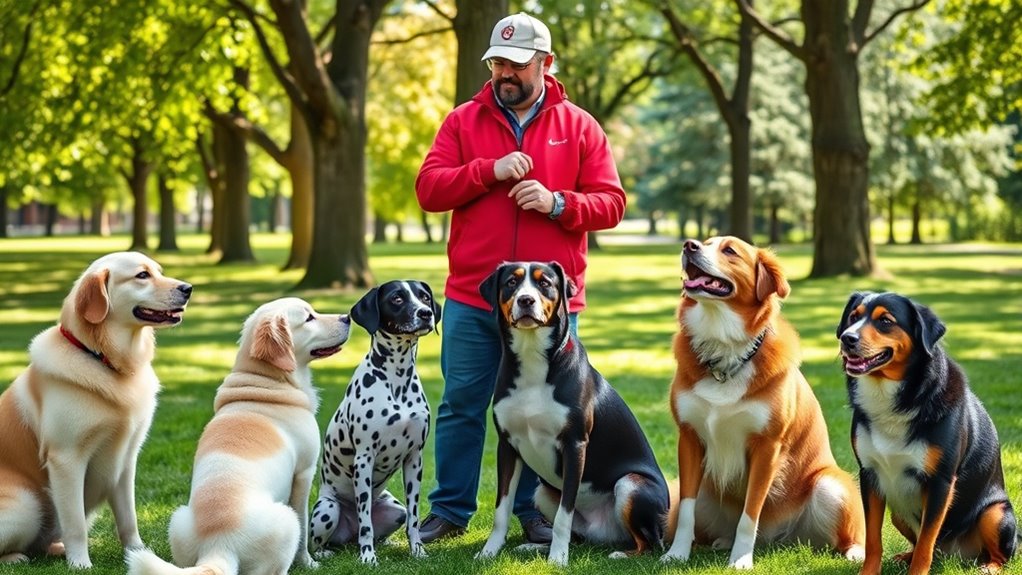To train multiple dogs at once, focus on consistency, setting clear boundaries, and socialization. Use commands like “sit” and “stay,” and practice short, positive sessions to keep everyone engaged. Incorporate crate training and individual attention to prevent jealousy and build confidence. Manage their activities with structured play and exercise, adjusting your approach for each dog’s needs. Keep routines steady, and if you keep following these tips, you’ll develop a happy, well-behaved pack.
Key Takeaways
- Use clear, consistent commands and routines for all dogs to reinforce understanding and cooperation.
- Train in short, focused sessions to maintain attention and prevent overwhelm.
- Incorporate individual training time to address each dog’s specific needs and behaviors.
- Manage space with separate leashes or long lines during walks and training to maintain control.
- Reinforce positive behaviors with treats and praise, ensuring a calm, balanced learning environment.

Training multiple dogs at once can be a rewarding experience, but it requires careful planning and consistency. When you’re managing more than one pup, establishing a solid foundation in dog socialization is essential. Proper socialization helps your dogs feel comfortable around each other and other people, reducing chances of conflict or anxiety. To do this effectively, expose them gradually to various environments, sounds, and individuals, always monitoring their reactions. Encourage calm interactions, rewarding positive behavior with treats or praise. This process builds confidence and helps your dogs learn appropriate social cues, making group training smoother.
Crate training is another critical aspect when raising multiple dogs. Implementing effective crate training tips can create a safe space for each dog and minimize chaos during training sessions. Start by introducing each crate as a cozy, inviting spot—place treats, toys, and comfortable bedding inside. Use positive reinforcement to encourage your dogs to enter voluntarily, avoiding punishment or force. Consistency is key; establish a routine where each dog spends time in their crate, especially during rest periods and when you’re unable to supervise. This helps prevent destructive behaviors and guarantees they associate the crate with safety and calmness. Remember, never leave dogs crated together for extended periods, as this can cause stress or territorial disputes.
When training multiple dogs simultaneously, it’s essential to set clear boundaries and expectations. Use commands like “sit,” “stay,” and “leave it” consistently across all dogs. Practice training sessions in short, focused intervals to maintain their attention. You can train them together on basic commands, but also allocate individual time to address specific needs or behaviors. This balance helps each dog develop independence and reduces reliance on pack behavior. Keep training sessions positive and engaging, using treats and praise as incentives. Be mindful of different learning paces; some dogs may pick up commands faster than others, so tailor your approach accordingly. Recognizing the importance of patience, as literature often emphasizes, is key to successful training.
Managing multiple dogs also means being organized. Use separate leashes or a long line to maintain control during walks and training. Ensure each dog has individual attention, so no one feels left out or jealous. Incorporate structured play and exercise to burn off excess energy, which can improve their focus during training. Lastly, patience is paramount. Training multiple dogs takes time and effort, but with consistency, clear boundaries, and a focus on socialization and crate training tips, you’ll foster well-behaved, happy companions who thrive in a pack environment.
Frequently Asked Questions
How Do I Prevent My Dogs From Distracting Each Other During Training?
To prevent your dogs from distracting each other during training, set up separate training areas so they focus individually. Use individual attention times to reinforce commands and build confidence. Keep sessions short and engaging, and reward each dog separately for their progress. Consistency is key—by providing focused, distraction-free environments, your dogs will learn more effectively and stay attentive during training sessions.
What Are the Best Rewards for Training Multiple Dogs Simultaneously?
The best rewards for training multiple dogs are high-value treats and perfect praise timing. Imagine each dog’s eyes lighting up as they anticipate their reward—your treat selection makes all the difference. Use tasty treats, like small pieces of chicken or cheese, and deliver praise immediately after good behavior. This keeps their focus sharp and strengthens their understanding, ensuring each dog feels rewarded and motivated without distraction.
How Can I Identify Individual Progress Among Multiple Dogs?
To identify individual progress among your dogs, focus on training tracking by observing each dog’s response to commands and noting improvements over time. Use separate training logs or videos to monitor behaviors individually. Pay attention to their engagement levels, response times, and consistency. Regularly assess each dog’s skills and avoid comparing them directly. This personalized approach helps you recognize individual progress and tailor your training to meet each dog’s needs effectively.
What Are Common Behavioral Issues When Training Multiple Dogs Together?
When training multiple dogs together, common behavioral issues include dominance struggles, barking, and distraction caused by group dynamics. Leash management is vital to prevent pulling or conflicts during walks. You might notice some dogs trying to assert control or becoming overly excited, which can disrupt others. Staying consistent, maintaining clear commands, and managing leash tension help keep training focused and reduce these issues.
How Long Should Each Training Session Last for Multiple Dogs?
You should aim for training sessions lasting about 10 to 15 minutes each for multiple dogs. This duration helps with duration management, keeping their attention without overwhelming them. Keep session consistency by sticking to a regular schedule, so your dogs know what to expect. Short, focused sessions build good habits and prevent fatigue or boredom, making training more effective for each dog and easier for you to manage.
Conclusion
Training multiple dogs at once might feel like orchestrating a symphony with a hundred instruments, but with patience and consistency, you’ll turn chaos into harmony. Before you know it, your pack will be so well-trained, they’ll rival the precision of a military drill team. Remember, every command is a brushstroke on the masterpiece of your shared life. Keep at it, and soon your home will be the envy of every dog trainer in the universe.










